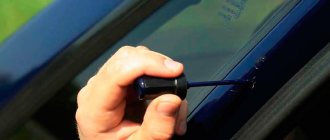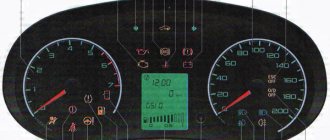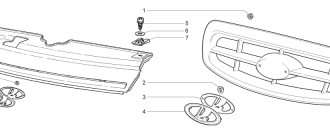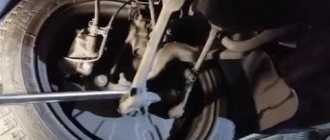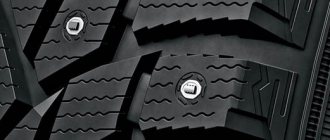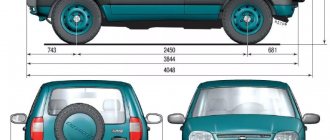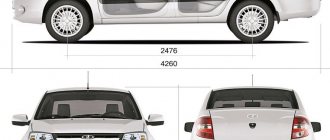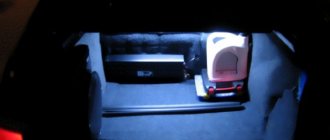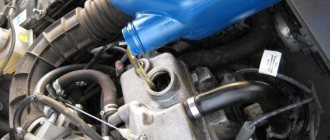Good day, dear readers! In the fourth issue of the BZ we will talk about small “jambs” that began to appear in my Lada Granta in the first hundreds of kilometers.
So, after installing the Methane gas system, my everyday work as a taxi driver began. As already mentioned in the 2nd issue of the BZ, the operation of the manual transmission and sound insulation of the new Lada Granta left much to be desired, and as the car was used, new “jambs” began to be added to these minor troubles. Let me make a reservation right away that all these “childhood diseases” are treated through simple manipulations, and some do not attach any importance to them at all. Therefore, my comments are not a “stone in the garden” of the Lada Grant, but a simple statement of facts, so to speak, my purely personal feelings from the operation of the car.
Lada Granta rear suspension creaking
Literally in the first hundred kilometers (mileage 300-400 km), driving on an uneven road, an annoying creaking noise began to appear in the rear suspension, both on the left and on the right. Even when buying a car, the manager warned that after 2 thousand km. at zero maintenance, the entire “running system” will definitely be stretched in order to eliminate the resulting gaps. It looks like these gaps have already begun to “form”, I thought, hence the creaking.
Since the specifics of working in a taxi involve long daily runs (150-200 km), 2000 km should have come very soon. For this reason, I did not do anything about these squeaks, but decided to wait for zero maintenance.
How does a car work?
You can understand where the extraneous sound comes from by understanding the structure of the car.
Suspension
The purpose of the suspension is the connection between the wheels and the car body. The suspension helps smooth out bumps due to the fact that the wheels work independently of the body.
It consists of:
- springs, springs;
- shock absorbers;
- levers - to connect the wheels with the body;
- supports;
- connecting elements (silent blocks, hinges, ball joints).
Cause of extraneous noise
The cause of extraneous noise may be hidden in the suspension. Main reasons:
- Faulty levers (play in the joints, possible failure of silent blocks).
- Shock absorber failure or spring break. In this case, a knock appears when overcoming bumps.
If a cracking sound occurs when turning, the CV joint is to blame. It cannot be repaired and must be replaced.
Brake system
In general terms, the braking system consists of:
- brake drive (brake pedal, brake master cylinder, pressure regulator, vacuum booster, pipes);
- brake mechanism (brake discs or drums and the pads themselves);
- in some cases - electronic control elements (ABS).
When braking there is a knocking sound in the rear wheel "Grants"
When braking, a knocking sound in the rear wheel of the Granta indicates wear or contamination of the brake system elements. The most common cause is rubbing handbrake cable guides. It needs to be tightened or replaced.
Steering system
The steering system is necessary to control a car. It consists of:
- steering wheel;
- cardan;
- electric booster;
- steering rod;
- tie rod ends.
Sounds emanating when turning the steering wheel indicate loosening of the components, partial or complete wear of the bushings. If the anthers are damaged, dirt can get inside the mechanisms, which causes a grinding noise.
Exhaust system
The exhaust system includes a manifold, catalyst, exhaust pipe, muffler, and resonator.
If extraneous noise appears in the exhaust system, it is necessary to check the fastenings of all elements. The resonator may burn out, and a loud growl will be heard from under the car.
Lada Granta side windows rattling
At the time of purchasing Granta, the temperatures outside were above zero, but winter soon began, and with it came the rattling of the side windows in the doors. The rear windows began to cause particular problems. If I have electric windows on the front doors and I can “pull” the glass up at any time, then the rear doors have ordinary “oars”, which for some reason constantly fall down along with the glass while driving. This makes the glass begin to rattle even more.
The feeling is very unpleasant, especially when you are carrying a passenger, and everything inside is rattling and rattling. The passenger probably thinks: “What kind of trough is this?... But it looks like new.” It is clear that this rattling can be easily eliminated by installing the hose into the seal (the Internet is full of videos on this topic). However, it’s winter outside and it’s cold in the garage, so I left the rattling noise alone until better times, but for now I decided to just periodically tighten the rear windows.
Where do extraneous sounds come from?
The causes of extraneous sounds are varied. Some problems can be solved on your own.
Dirty pads or their critical wear
An unpleasant squeal can be heard in the area of the front wheels when braking. The pads consist of a friction clutch and a metal base. During braking, the clutch wears off and the metal base comes into use. A characteristic sound of grinding metal appears.
Dirty pads
If new pads are installed, but the unpleasant noise remains, do not panic. This may be due to uneven disc wear. As you move, the pads will rub in and the extraneous noise will disappear. A problem with the rear pads can occur if they are installed incorrectly. Watch how the pads are installed.
Steering faults
The load has a strong influence on the ball joints. If they are worn out, a characteristic knocking sound is heard in the area of the right and left wheels. Immediate diagnosis is necessary.
If the caliper breaks, you will hear a squeaking and grinding noise. This is caused by jamming of the working cylinder or caliper guides. The pads are constantly pressed. This is caused by:
- a leaky boot that could become clogged with dirt;
- oxidation of the cylinder itself or the guides, which prevents it from returning to its original position.
Steering faults
This problem can be diagnosed by feeling the deterioration of the roll and slightly pulling towards the pinched wheel.
Mechanical damage
Large uneven roads wear out the suspension, which can also be indicated by noise from the front of the car. The problem could be a worn wheel bearing or CV joint.
The protective shield (metal casing of the brake disc) may be deformed.
Incorrect wheel size
A grinding noise may appear after installing wheels of larger diameter when they rub against the arch. It is necessary to install a tire size that meets the requirements for a particular vehicle.
Creaking in the cabin or “live” Lada Granta
Has this ever happened to you when suddenly something somewhere could “prick”, “get sick”, but then go away just as quickly as it started? This happens to everyone and we don’t pay much attention to it, because different processes take place in a living organism, the essence of which we may not fully understand. So, what am I talking about? Lada Granta, it seems, is also a “living organism”. During the winter, strange things began to happen to her. For example, while driving, a strong creaking sound (cricket) could suddenly appear in the cabin, and in the most unexpected places. You’re driving along calmly, and then suddenly... and suddenly something starts to creak.
While you are racking your brains about what it could be, the creak could just as quickly disappear as it appeared. Of course, this can be easily explained. As the car warms up/cools down in winter, the interior elements begin to expand or contract (the law of physics), but at different speeds, because they are made of different materials. The gaps between the parts also begin to “walk,” which causes a squeak when one part begins to “rub” against another. After time, the mating parts should form their own “working gap” through friction and the “temperature” squeaks will go away (I would really like to believe this), but time will tell.
How to determine the cause of extraneous sounds
The appearance of extraneous sounds means that some mechanism has become unusable. Do not delay this issue until strange sounds lead to serious and expensive repairs.
Sound Source Localization
First you need to understand where the noise came from. To do this, warm up the car and listen carefully to the engine compartment. Here you can understand from which mechanism the extraneous sound comes from.
Car stethoscope
Listen to how the car behaves on the road, whether there is a hum when accelerating or braking. Extraneous noise may occur when turning.
There is a special device for “listening” - a car stethoscope, with which it is easy to determine where the noise is coming from. The operating principle of a car device is the same as that of a medical stethoscope.
Most likely malfunctions
The table shows typical problems signaled by sound.
| Character of sound | Possible faults |
| Rumble | ● Wheel bearing hums ● Transmission malfunction |
| Knock | ● Play in ball joints ● Steering rack and pinion wear ● Wear of shock absorber pads ● Wear of support bearings ● Loose suspension fastenings |
| Grinding | ● Poor quality or worn brake pads ● Deformation of the brake disc guard ● Wheel friction on the arch ● Uneven wear and scoring on the disc or drum. |
Diagnostics on a lift
A lift will help check the suspension for play. Turn each lever in different directions one by one. If serious play appears, repair the identified damage. It is from this node that the extraneous sound is emitted.
Lada Granta paint chips
The first trip to Chelyabinsk (150 km from Zlatoust) was a serious blow to the paintwork. Imagine my surprise and disappointment when, after the first trip, I discovered numerous chips in the paintwork (I counted about 20 chips). Moreover, they were not only on the hood, but also on the doors. To be honest, I was not ready for this.
Now, in order to stick on the “armor,” you first need to touch up the chips with a pencil and bring the paintwork into proper condition. However, it’s winter outside, and at sub-zero temperatures in the garage, this will be difficult to do, to put it mildly, so we’re waiting for the warmth... I plan to record the entire repair process and post it in one of the issues of the BZ. Below in the photo you can see examples of chips and their sizes.
Photo 1: Chips in paintwork on Lada Granta
Maybe the reason for such chips is not the quality of the paintwork as such, but the peculiarities of our area? I will try to clearly demonstrate what I mean.
Carefully! "Stone bullets" on the road
In the Urals, the terrain is predominantly mountainous, but I’m generally silent about Zlatoust :)). In our city and beyond, horizontal surfaces are in great short supply! Therefore, to prevent cars from “piling up” under every hill in winter, the roads are generously sprinkled with “dropouts” (and not only the roads). Crushed stone screening is a by-product from the processing of hard rocks or, simply put, production waste. Since there are many mining enterprises in our territory, the by-product of which is “screenings” - we have it as “dirt”. The photo below shows what it is.
Photo 2: Screening as an anti-icing powder
Now it’s not difficult to imagine how these “stone bullets” fly out from under the wheels of oncoming cars and “attack” your car. I wonder how fast they fly into the arms of your paintwork? Let's do the math. For example, you are moving along the highway at a speed of 100 km/h, and an oncoming truck is rushing at a speed of 90 km/h. A small pebble flying out from under the wheel of a “truck” also has its own speed (+60 km/h). By adding the speeds, we get no less than 250 km/h. This is approximately the speed at which this “rock bullet” penetrates your paintwork. And the more “dropouts” on the road, the higher the likelihood of getting caught in “crossfire.” What kind of paintwork will withstand this? Yes..., only polyurethane armored film will help us (don’t even consider vinyl film, it’s just decor).
How to tighten the handbrake on a Lada Granta with your own hands: adjustment + photos and videos
Incorrect operation of the handbrake can cause an accident or some other serious incident.
Introduction
For example, even with the simplest job of replacing a broken tire, you must put the car on the handbrake, otherwise you risk “putting” the car on the bumper as a result of the car “driving” forward. And this is not the worst thing that can happen! You may cause yourself serious physical harm.
Toyota BB was dropped on the asphaltClassic fell from a jack
Necessary tool for tightening the handbrake
8 socket for ratchet Partner (preferably the coolest car mechanic)
- Two keys for 13. It is advisable that one of them be a socket.
- Head 8.
- A partner, but you can do without him. The truth is it’s more difficult without him.
The principle of adjusting the handbrake
- Fully lower the handbrake lever in the cabin.
Lower the handbrake handle - Place the car on a pit or lift it on a lift. Some car owners manage to adjust the handbrake “from the curb” - but this is inconvenient and dangerous.
- Find the resonator from the bottom of the car and remove it from the rubber brackets.
Remove the muffler from its mounting to the body - Using a ratchet, unscrew the 4 bolts securing the protection of the handbrake adjustment mechanism (protective screen).
Remove and set aside the protective screen - Next, you can either remove the protective screen, but it seems to me that it is easier to move it forward behind the muffler, which will free up space that is enough for free work.
The mechanism looks like this - Loosen the first nut with a 13mm wrench.
Weaken - By tightening the adjusting nut, tighten the handbrake cable that comes out of the passenger compartment.
- Ask a partner to check the stroke of the lever handle, or check it yourself.
- As soon as the handbrake moves 3-4 clicks, tighten the lock nut.
- Before the final stage of work, it is necessary to check the functionality of the brake mechanism. To do this, hang the rear wheels and watch how they rotate with the hand brake off. They also check how the wheels grip when the handbrake is raised.
- Next, return the protective screen to its place, screw it onto the seats and put rubber fasteners on the resonator.
Handbrake adjustment video
The principle of operation of the handbrake on Grant
Why does it need to be tightened frequently?
This is the peculiarity of the mechanism, which is why you often have to tighten the handbrake. Plus low-quality spare parts from the beginning, and a design that has not changed since the time of Tsar Pea!
How a properly configured handbrake should work
The handbrake movement in a Lada Granta car should be no more than 6 clicks from the moment it is raised. It is possible to increase the handbrake stroke to 8 clicks, but it is not recommended.
It shouldn’t be like this (the brakes don’t grab the rear wheels)
Ideally, of course, 3-4 clicks. With this setting of the handbrake, you will have a reserve of movement when the cable weakens and the wheels begin to grip later.
If you experience a situation where the handbrake is “pulled out” to its fullest extent, but the wheels do not grab, then the following reasons are possible:
- rear brake pads are worn out;
- the handbrake cable is broken or stretched/
Useful tips
You can fully check the correct operation of the handbrake on a hill at 23 degrees. With the handbrake lever fully raised, the car should stand still in a disengaged gear.
Source: https://carfrance.ru/podtyagivaem-ruchnik-na-lada-granta-regulirovka-i-podtyazhka-trosa/
Passenger door handles Lada Granta
Another problem I had was with the passenger door handles, which very quickly lost their “pristine appearance.” The silver paint on them began to peel off literally from the first days of use. The photo below shows what I mean.
Photo 3: Paint peeled off by wedding rings on the Lada Granta door handle
Why does this happen? The paint is peeled off like a scraper by the wedding rings on the passengers' right hands, and in a day there can be many such passengers in a taxi. Repainting the handle trims is not an option. The only way to preserve the “pristine appearance” of door handles for some time is to cover them with film. I haven’t decided yet what kind of film it will be in my case. In one of the next issues of the in-flight magazine I will definitely share the solution to this problem.
Perhaps these are all the minor troubles that caught my attention, and which I plan to address in the near future. See you again in new issues of the BZ!
To begin with, about what and why it creaks
The dashboard, “tidy”, as they call it, is the instrument panel, which is located in the cabin under the windshield, directly in front of the driver and passenger seat. The purpose of the instrument panel is, as a rule, purely aesthetic; it hides a large number of wires and components located in the cabin, making it more attractive. Also on the instrument panel there are often various gadgets, a passenger airbag and the electronic instrument panel itself (speedometer, tachometer and other indicators and control lights).
In most cases, dashboards are made of elastic, but not hard materials; initially, this decision had one goal - ensuring safety in the event of an accident. However, with the advent of the Airbag, or more simply put, “airbags,” the instrument panel has become nothing more than just a beautiful shelf, the design of which is carried out by entire creative studios in order to attract the attention of a fastidious buyer. Basically, the “tidy” is made from soft foam compounds based on polyurethane foam or polyolefin, which do not withstand temperature changes and increased vibrations. The latter is very relevant for our roads, which are more like a test track or a washboard, and certainly not a public road.
